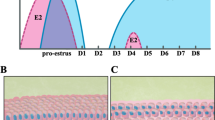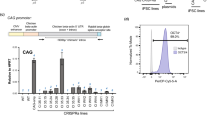Abstract
Purpose
To investigate the effect of epigenetic modification on pattern, time and capacity of transcription activation of POU5F1, the key marker of pluripotency, in cloned bovine embryos.
Methods
Bovine fibroblasts were stably transfected with POU5F1 promoter-driven enhanced green fluorescent protein (EGFP). This provided a visible marker to investigate the effect of post-activation treatment of cloned bovine embryos with trichostatin A (TSA) on time and capacity of POU5F1 expression and its subsequent effect on in vitro development of cloned bovine embryos.
Results
Irrespective of TSA treatment, POU5F1 expression was not detected until 8–16 cell stage, but was detected in both inner cell mass and trophectoderm at the blastocyst stage. TSA treatment significantly increased POU5F1 expression, and the yield and quality of cloned embryo development compared to control.
Conclusion
The POU5F1 expression of cloned embryos is strictly controlled by the stage of embryo development and may not be altered by TSA-mediated changes occur in DNA-methylation and histone-acetylation of the genome.



Similar content being viewed by others
References
Wilmut I, Beaujean N, De Sousa PA, Dinnyes A, King TJ, Paterson LA, et al. Somatic cell nuclear transfer. Nature. 2002;419:583–6.
Zhao J, Hao Y, Ross JW, Spate LD, Walters EM, Samuel MS, et al. Histone deacetylase inhibitors improve in vitro and in vivo developmental competence of somatic cell nuclear transfer porcine embryos. Cell Reprogram. 2010;12:75–83.
Iager AE, Ragina NP, Ross PJ, Beyhan Z, Cunniff K, Rodriguez RM, et al. Trichostatin A improves histone acetylation in bovine somatic cell nuclear transfer early embryos. Clon Stem Cells. 2008;10:371–9.
Tsuji Y, Kato Y, Tsunoda Y. The developmental potential of mouse somatic cell nuclear-transferred oocytes treated with trichostatin A and 5-aza-2′-deoxycytidine. Zygote. 2009;17:109–15.
Jeon BG, Coppola G, Perrault SD, Rho GJ, Betts D, King WA. S-adenosylhomocysteine treatment of adult female fibroblasts alters X-chromosome inactivation and improves in vitro embryo development after somatic cell nuclear transfer. Reproduction. 2008;135:815–28.
Tian XC, Park J, Bruno R, French R, Jiang L, Prather RS. Altered gene expression in cloned piglets. Reprod Fertil Dev. 2009;21:60–6.
Yoshida M, Horinouchi S, Beppu T. Trichostatin A and trapoxin: novel chemical probes for the role of histone acetylation in chromatin structure and function. Bioassays. 1995;17:423–30.
Jafarpour F, Hosseini SM, Hajian M, Forouzanfar M, Ostadhosseini S, Abedi P, et al. Somatic-cell-induced hyperacetylation, but not hypomethylation, positively and reversibly affects the efficiency of in vitro cloned blastocyst production in cattle. Cellular Reprogramming. 2011. doi:10.1089/cell.2011.0005.
Cervera RP, Martí-Gutiérrez N, Escorihuela E, Moreno R, Stojkovic M. Trichostatin A affects histone acetylation and gene expression in porcine somatic cell nucleus transfer embryos. Theriogenology. 2009;72:1097–110.
Wuensch A, Habermann FA, Kurosaka S, Klose R, Zakhartchenko V, Reichenbach HD, et al. Quantitative monitoring of pluripotency gene activation after somatic cloning in cattle. Biol Reprod. 2007;76:983–91.
Kirchhof N, Carnwath JW, Lemme E, Anastassiadis K, Scholer H, Niemann H. Expression pattern of Oct-4 in preimplantation embryos of different species. Biol Reprod. 2000;63:1698–705.
Hosseini SM, Moulavi F, Foruzanfar M, Hajian M, Abedi P, Memar M, et al. Effect of donor cell type and gender on the efficiency of in vitro sheep somatic cell cloning. Small Rum Res. 2008;78:162–8.
Nasr-Esfahani MH, Hosseini SM, Hajian M, Forouzanfar M, Ostadhosseini S, Abedi P, et al. Development of an optimized zona-free method of somatic cell nuclear transfer in the goat. Cell Reprogram. 2011;13:157–70.
Campbell KHS. Nuclear equivalence, nuclear transfer, and the cell cycle. Cloning. 1999;1:3–15.
Hosseini SM, Hajian M, Moulavi F, Abedi P, Forouzanfar M, Ostadhosseini S, et al. Highly efficient in vitro production of bovine blastocysts in cell-free sequential synthetic oviductal fluid VS. TCM 199 vero cell co-culture system. IJFS. 2008;2:66–73.
Oback B, Wiersema AT, Gaynor P, Laible G, Tucker FC, Oliver JE, et al. Cloned cattle derived from a novel zona-free embryo reconstruction system. Cloning Stem Cells. 2003;5:3–12.
Hosseini SM, Hajian M, Moulavi F, Shahverdi AH, Nasr-Esfahani MH. Optimized combined electrical and chemical activation of in vitro matured bovine oocytes. Anim Reprod Sci. 2006;108:122–33.
Vajta G, Peura TT, Holm P, Pald A, Greve T, Trounson AO, et al. New method for culture of zona-included or zona-free embryos: the Well of the Well (WOW) system. Mol Reprod Dev. 2000;55:256–64.
Jafari Sh, Hosseini SM, Hajian M, Forouzanfar M, Jafarpour F, Abedi P, Ostadhosseini S, Abbasi H, Gourabi H, Shahverdi AH, Vosough Taghi Dizaj AD, Nasr-Esfahani MH. Improved in vitro development of cloned bovine embryos using S-adenosylhomocysteine, the non-toxic epigenetic modifying reagent. Mol Reprod Dev. [Epub ahead of print]
Beaujean N, Hartshorne G, Cavilla J, Taylor J, Gardner J, Wilmut I, et al. Young: non-conservation of mammalian preimplantation methylation dynamics. Curr Biol. 2004;14:266–7.
Moulavi F, Hosseini SM, Ashtiani SK, Shahverdi A, Nasr-Esfahani MH. Can Vero cell co-culture improve in-vitro maturation of bovine oocytes. Reprod Biomed Online. 2006;13:404–11.
Dean W, Santos F, Stojkovic M, Zakhartchenko V, Walter J, Wolf E, et al. Conservation of methylation reprogramming in mammalian development: aberrant reprogramming in cloned embryos. Proc Natl Acad Sci USA. 2001;98:13734–8.
Santos F, Zakhartchenko V, Stojkovic M, Peters A, Jenuwein T, Wolf E, et al. Epigenetic marking correlates with developmental potential in cloned bovine preimplantation embryos. Curr Biol. 2003;13:1116–21.
Kang Y, Koo D, Park J, Choi Y, Chung A, Lee K, et al. Aberrant methylation of donor genome in cloned bovine embryos. Nat Genet. 2001;28:173–7.
Cedar H, Bergman Y. Linking DNA methylation and histone modification: patterns and paradigms. Nat Rev Genet. 2009;10:295–304.
Li J, Svarcova O, Villemoes K, Kragh PM, Schmidt M, Bøgh IB, et al. High in vitro development after somatic cell nuclear transfer and trichostatin A treatment of reconstructed porcine embryos. Theriogenology. 2008;70:800–8.
Wang F, Kou Z, Zhang Y, Gao S. Dynamic reprogramming of histone acetylation and methylation in the first cell cycle of cloned mouse embryos. Biol Reprod. 2007;77:1007–16.
Martinez-Diaz MA, Che L, Albornoz M, Seneda MM, Collis D, Coutinho AR, et al. Pre- and postimplantation development of swine-cloned embryos derived from fibroblasts and bone marrow cells after inhibition of histone deacetylases. Cell Reprogram. 2010;12:85–94.
Yamanaka K, Sugimura S, Wakai T, Kawahara M, Sato E. Acetylation level of histone H3 in early embryonic stages affects subsequent development of miniature pig somatic cell nuclear transfer embryos. J Reprod Dev. 2009;55:638–44.
Cibelli JB, Kocabas AM, Beyhan Z, Ross PJ. Cellular reprogramming for the creation of patient-specific embryonic stem cells. Stem Cell Rev. 2006;2:289–95.
Wang YS, Xiong XR, An ZX, Wang LJ, Liu J, Quan FS, et al. Production of cloned calves by combination treatment of both donor cells and early cloned embryos with 5-aza-2/-deoxycytidine and trichostatin A. Theriogenology. 2011;15:819–25.
Hansis C, Tang YX, Grifo JA, Krey LC. Analysis of Oct-4 expression and ploidy in individual human blastomeres. Mol Hum Reprod. 2001;7:155–61.
Acknowledgements
This study was funded by a grant from the Royan Institute of IRI. All the study was carried out in Royan Institute, IRI. The authors would like to thank Mrs. Hosseini for ovum pick up assistance. Authors also sincerely thank Mrs Mansouri for statistical analysis and Mr. Heidari, and Khajeh for preparation the ovaries.
Author information
Authors and Affiliations
Corresponding authors
Additional information
Authors contribution
Conceived and designed the experiments: SMH, FJ, MHN. Performed the experiments: SMH, MH, MF, FJ, PA, SO, HA, SJ. Analyzed the data: SMH, MHN. Contributed reagents/materials/analysis tools: MHN, HG, AHS, ADV. Wrote the paper: SMH, MHN.
Capsule
Epigenetic modification and cloning efficiency
Rights and permissions
About this article
Cite this article
Jafari, S., Hosseini, S.M., Hajian, M. et al. Epigenetic modification does not determine the time of POU5F1 transcription activation in cloned bovine embryos. J Assist Reprod Genet 28, 1119–1127 (2011). https://doi.org/10.1007/s10815-011-9638-1
Received:
Accepted:
Published:
Issue Date:
DOI: https://doi.org/10.1007/s10815-011-9638-1




